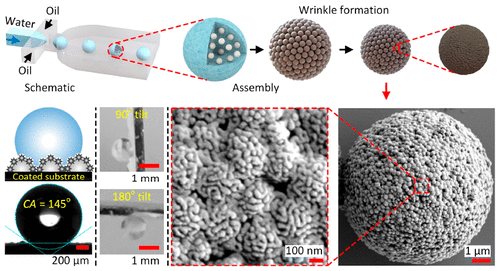Our official English website, www.x-mol.net, welcomes your
feedback! (Note: you will need to create a separate account there.)
Microfluidics Assisted Fabrication of Three-Tier Hierarchical Microparticles for Constructing Bioinspired Surfaces.
ACS Nano ( IF 15.8 ) Pub Date : 2019-03-11 00:00:00 , DOI: 10.1021/acsnano.9b00245
Juan Wang 1, 2 , Hai Le-The 2 , Zuankai Wang 3 , Hao Li 1 , Mingliang Jin 1 , Albert van den Berg 2 , Guofu Zhou 1 , Loes I Segerink 2 , Lingling Shui 1, 4 , Jan C T Eijkel 2
ACS Nano ( IF 15.8 ) Pub Date : 2019-03-11 00:00:00 , DOI: 10.1021/acsnano.9b00245
Juan Wang 1, 2 , Hai Le-The 2 , Zuankai Wang 3 , Hao Li 1 , Mingliang Jin 1 , Albert van den Berg 2 , Guofu Zhou 1 , Loes I Segerink 2 , Lingling Shui 1, 4 , Jan C T Eijkel 2
Affiliation

|
Construction of textured bioinspired surfaces with refined structures that exhibit superior wetting properties is of great importance for many applications ranging from self-cleaning, antibiofouling, anti-icing, oil/water separation, smart membrane, and microfluidic devices. Previously, the preparation of artificial surfaces generally relies on the combination of different approaches together, which is a lack of flexibility to control over the individual architecture unit, the surface topology, as well as the complex procedure needed. In this work, we report a method for rapid fabrication of three-tier hierarchical microunits (structures consisting of multiple levels) using a facile droplet microfluidics approach. These units include the first-tier microspheres consisting of the second-tier close-packed polystyrene (PS) nanoparticles decorated with the third-tier elegant polymer nanowrinkles. These nanowrinkles on the PS nanoparticles are formed according to the interfacial instability induced by gradient photopolymerization of N-isopropylacrylamide (NIPAM) monomers. The formation process and topologies of nanowrinkles can be regulated by the photopolymerization process and the fraction of carboxylic groups on the PS nanoparticle surface. Such a hierarchical microsphere mimics individual units of bioinspired surfaces. Therefore, the surfaces from self-assembly of these fabricated two-tier and three-tier hierarchical microunits collectively exhibit “gecko” and “rose petal” wetting states, with the micro- and nanoscale structures amplifying the initial hydrophobicity but still being highly adhesive to water. This approach offers promising advantages of high-yield fabrication, precise control over the size and component of the microspheres, and integration of microfluidic droplet generation, colloidal nanoparticle self-assembly, and interfacial polymerization-induced nanowrinkles in a straightforward manner.
中文翻译:

微流体辅助制造的三层分层微粒,用于构建生物启发性表面。
具有精致的结构,表现出优异的润湿性能的带纹理的生物启发表面的构造对于许多应用非常重要,这些应用包括自清洁,防生物结垢,防结冰,油/水分离,智能膜和微流体设备。以前,人造表面的制备通常依赖于不同方法的组合,这缺乏控制单个建筑单元,表面拓扑以及所需复杂程序的灵活性。在这项工作中,我们报告了一种使用简便的液滴微流控方法快速制造三层分层微单元(由多个级别组成的结构)的方法。这些单元包括第一层微球,该微球由第二层紧密堆积的聚苯乙烯(PS)纳米颗粒组成,并装饰有第三层优雅的聚合物纳米皱纹。这些PS纳米颗粒上的纳米皱纹是根据梯度光聚合引起的界面不稳定性而形成的。ñ-异丙基丙烯酰胺(NIPAM)单体。纳米皱纹的形成过程和拓扑结构可以通过光聚合过程和PS纳米颗粒表面上羧基的比例来控制。这种分层的微球模仿了生物启发性表面的各个单元。因此,这些制造的两层和三层分层微单元的自组装表面共同表现出“壁虎”和“玫瑰花瓣”的润湿状态,其中微米和纳米级结构放大了初始疏水性,但仍具有很高的粘附力水。这种方法具有高产量的制造,对微球尺寸和组成的精确控制以及微流液滴生成,胶体纳米粒子自组装,
更新日期:2019-03-11
中文翻译:

微流体辅助制造的三层分层微粒,用于构建生物启发性表面。
具有精致的结构,表现出优异的润湿性能的带纹理的生物启发表面的构造对于许多应用非常重要,这些应用包括自清洁,防生物结垢,防结冰,油/水分离,智能膜和微流体设备。以前,人造表面的制备通常依赖于不同方法的组合,这缺乏控制单个建筑单元,表面拓扑以及所需复杂程序的灵活性。在这项工作中,我们报告了一种使用简便的液滴微流控方法快速制造三层分层微单元(由多个级别组成的结构)的方法。这些单元包括第一层微球,该微球由第二层紧密堆积的聚苯乙烯(PS)纳米颗粒组成,并装饰有第三层优雅的聚合物纳米皱纹。这些PS纳米颗粒上的纳米皱纹是根据梯度光聚合引起的界面不稳定性而形成的。ñ-异丙基丙烯酰胺(NIPAM)单体。纳米皱纹的形成过程和拓扑结构可以通过光聚合过程和PS纳米颗粒表面上羧基的比例来控制。这种分层的微球模仿了生物启发性表面的各个单元。因此,这些制造的两层和三层分层微单元的自组装表面共同表现出“壁虎”和“玫瑰花瓣”的润湿状态,其中微米和纳米级结构放大了初始疏水性,但仍具有很高的粘附力水。这种方法具有高产量的制造,对微球尺寸和组成的精确控制以及微流液滴生成,胶体纳米粒子自组装,

































 京公网安备 11010802027423号
京公网安备 11010802027423号